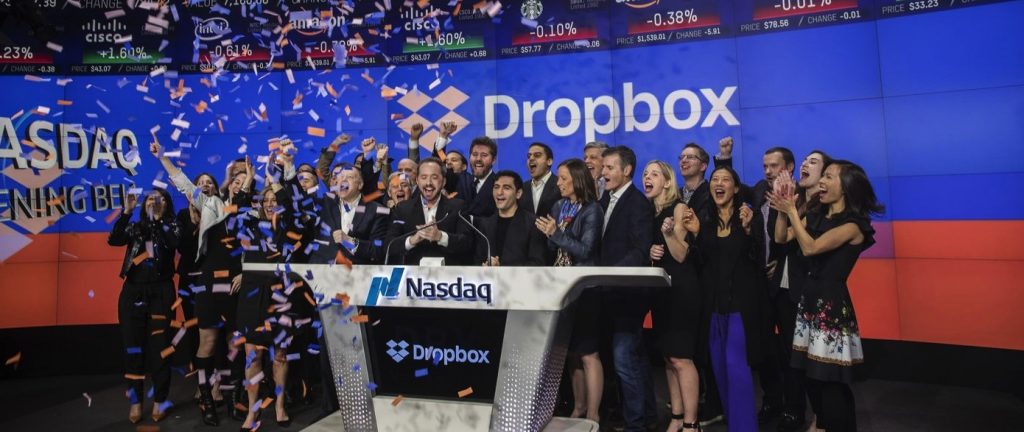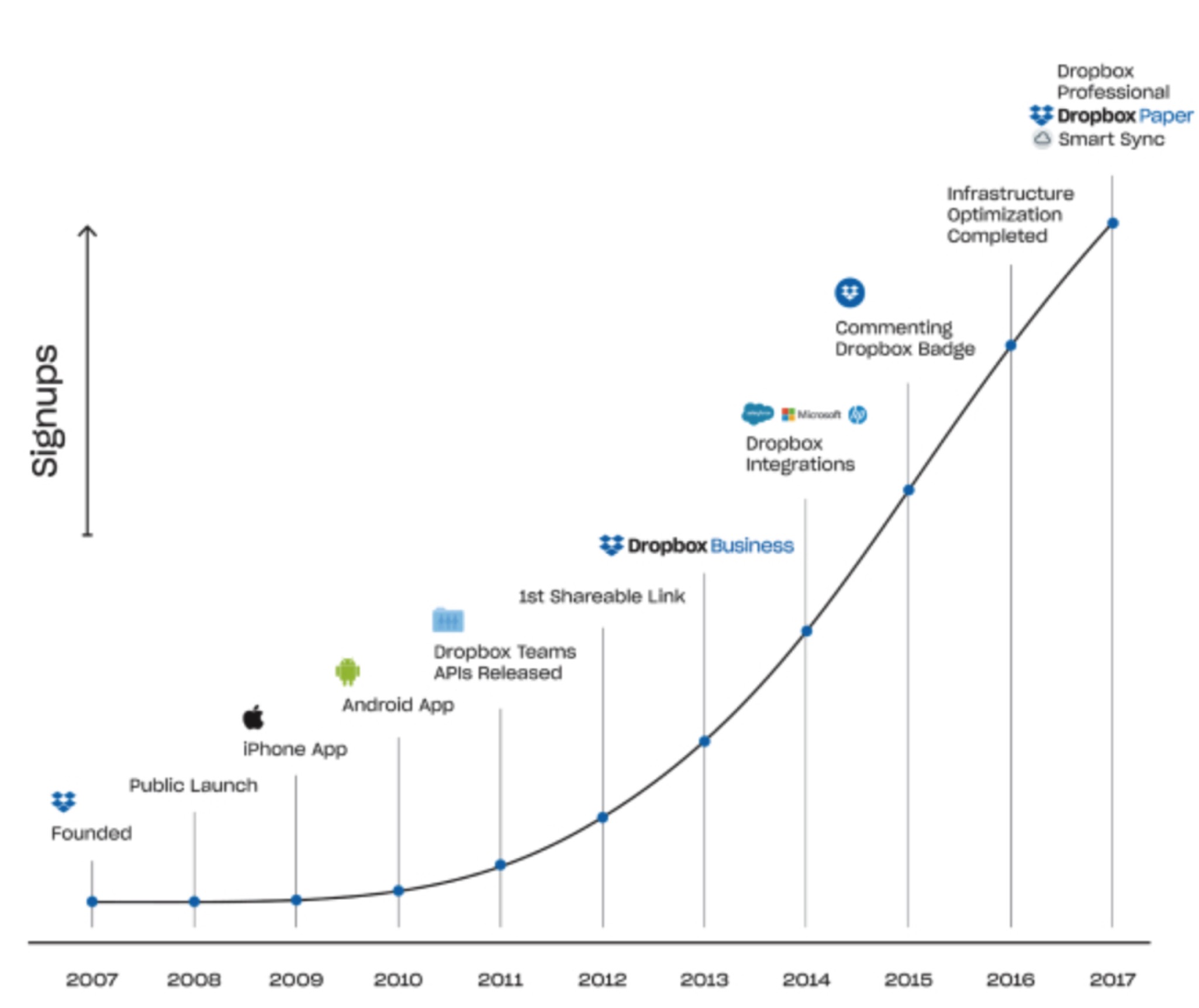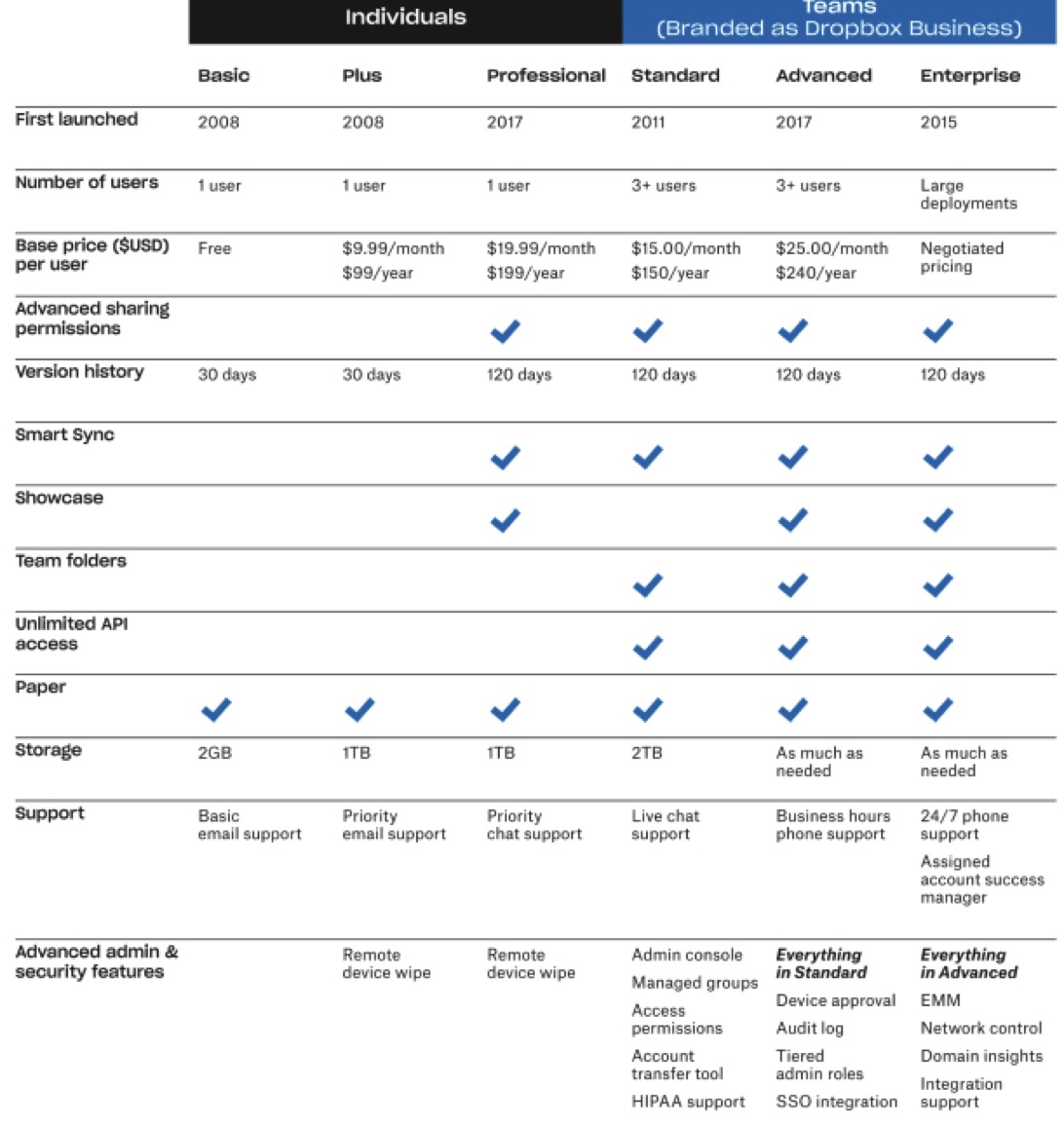Dropbox Raised $756 Million in IPO, Stock Up 36%
2017 revenue of $1.1 billion and never profitable
By Jean Jacques Maleval | March 28, 2018 at 2:23 pmIn a SEC filing, Dropbox, Inc. published a complete report on the company as it usual when you prepare an IPO (here for the second time) to appy to list Class A common stock on Nasdaq under the symbol DBX.

The company is valued at roughly $13 billion, including restricted stock units and options, a figure above the $10 billion it commanded during its last private fund-raising round.
Here is a summary and more of this 200+ pages SEC filing document.
Started by Arash Ferdowsi, 32, director (total compensation of $47 million in 2017, 16% of class A shares), and Drew Houston, 34, chairman and CEO total compensation of $110 million in 2017, 38% of class A shares), the start-up was incorporated in May 2007 as Evenflow, Inc., a Delaware corporation, and changed its name to Dropbox, Inc. in October 2009, now with HQs in San Francisco, CA where total minimum obligations under the lease agreement are expected to be $827 million. It leases additional offices around the world, including in Austin, TX; Seattle, WA; New York, NY; Dublin, Ireland; London, UK; Tel Aviv, Israel; Sydney, Australia; and Tokyo, Japan; with datacenter co-location facilities in California, Texas, and Virginia.
After receiving initial funding from seed accelerator Y Combinator, it raised a total of $1.7 billion from venture investors in financial funding including $1.2 million in series A funding from Sequoia Capital in 2007, and $250 million in 2011. In April 2017, it entered into a $600 million credit facility with a syndicate of financial institutions. Recently Salesforce Ventures, venture arm of partner Salesforce, decides to invest $100 million in Dropbox.
We have recorded several acquisitions at prices generally not revealed:
- in 2012 Cove, Snapjoy, in online photo library and software application, TapEngage, enabling advertisers and publishers to collaborate on tablet-optimized advertising and Audiogalaxy, to store their music files and playlists in the cloud,
- in 2013 Endorse, a mobile coupon start-up,
- in 2014 Loom, a cloud photo service, Bubbli, incorporating 3D technology into 2D views, and packaging it in a mobile app, Mailbox (for $100 million), in email app, and document-sharing startup Hackpad, and
- in 2015 CloudOn, provider of mobile applications for document editing and creation, and Clementine, an enterprise communication service.
It was founded with one idea: “life would be a lot better if everyone could access their most important information anytime from any device.” Market opportunity has grown with solution from keeping files in sync to keeping teams in sync for collaboration with more than 4.5 billion connections to shared content.
Dropbox also works with other products, integrating with partners from Google and Microsoft to Slack and Autodesk. More than 75% of Dropbox business teams have linked to one or more third-party applications. The insights from users lead to develop new product experiences, like Paper, Smart Sync, and Showcase. Machine learning further improves the user experience by enabling more intelligent search and better organization and utility of information. In 2017, over 40% of new business teams included a member who was previously a subscriber to one of individual paid plans.
Click to enlarge
Click to enlarge
The firm hosts services and serve all of users using a combination of own custom-built infrastructure that are leases and operates in co-location facilities and third-party datacenter services such as Amazon Web Services. Its platform is accessible from the web and from devices running Windows, Mac OS, iOS, Android, WindowsMobile, and Linux and has integration with Microsoft, Adobe, Apple, Salesforce, Atlassian, Slack, IBM, Cisco, VMware, Okta, Symantec, Palo Alto Networks, and other productivity, collaboration, data management, and security vendors.
Competitors include Amazon, Alphabet, Apple, Google, and Microsoft, and, in the content collaboration market, Atlassian, Google, and Microsoft.
As of December 31, 2017, the firm was receiving over 50 billion API calls per month, and more than 500,000 developers had registered and built applications on its platform.
In brief the start-up records $1.1 billion in revenue with 11 million paying users and 500 million registered users (which over 100 million signed up since the beginning of 2017) in 180 countries with 400 billion pieces of content totaling over 1EB of data.
More precisely, revenue was $603.8 million, $844.8 million, and $1,106.8 million in 2015, 2016, and 2017 (FY ended in December 31), respectively, representing an annual growth rate of 40% and 31%, respectively. As of December 31, 2017, more than 80% of annualized revenue came from existing individual users and Dropbox business teams who were on its platform as of December 31, 2016. It generates 90% of revenue from self-serve channels. By geography in 2017, USA represented 52% and international 48%.
Click to enlarge
Sales and marketing expenses increased $63.4 million or 25% during 2017, as compared to 2016, primarily due to an increase of $40.9 million in variable spend related to brand campaign fees, lead generation fees, and third-party sales representative fees.
The firm, never profitable, generated net losses of $325.9 million, $210.2 million, and $111.7 million in 2015, 2016, and 2017, respectively. It has an accumulated deficit of $1,049.7 million as of December 31, 2017.
It generated positive free cash flow of $137.4 million and $305.0 million in 2016 and 2017, respectively, compared to negative free cash flow of $63.9 million in 2015.
Average revenue per paying user was $113 in 2015, $111 in 2016 and $112 in 2017.
It generates over 90% of our revenue from self-serve channels—users who purchase a subscription through company’s app or website.
According to Wikipedia, Dropbox has been the subject of criticism and controversy related to multiple incidents, including a June 2011 authentication problem that let accounts be accessed for several hours without passwords a July 2011 Privacy Policy update with language suggesting Dropbox had ownership of users’ data, concerns about Dropbox employee access to users’ information, July 2012 email spam with recurrence in February 2013, leaked government documents in June 2013 with information that Dropbox was being considered for inclusion in the National Security Agency’s PRISM surveillance program, a July 2014 comment from NSA whistleblower Edward Snowden criticizing Dropbox’s encryption, the leak of 68 million account passwords on the Internet in August 2016, and a January 2017 accidental data restoration incident where years-old supposedly deleted files reappeared in users’ accounts.
Headcount has grown from 1,446 employees as of December 31, 2015, to 1,858 employees as of December 31, 2017.
The start-up never declared nor paid cash dividends on capital stock. It currently intends to retain any future earnings to finance the operation and expansion of its business, and do not expect to declare or pay any dividends in the foreseeable future.
It has over 600 issued patents and more than 600 pending patent applications in the United States and abroad.
As business evolves, Dropbox may need to invest more resources into sales to large organizations.















 Subscribe to our free daily newsletter
Subscribe to our free daily newsletter


